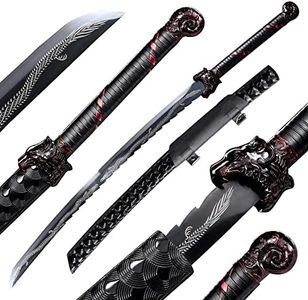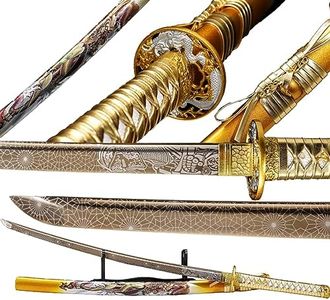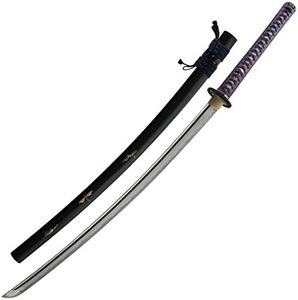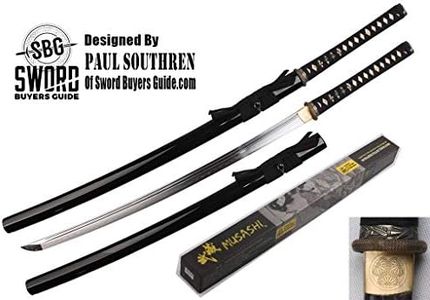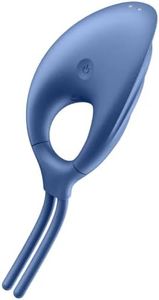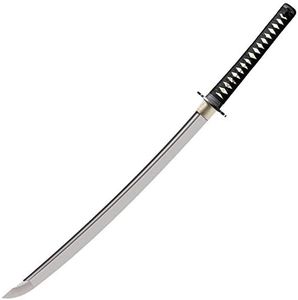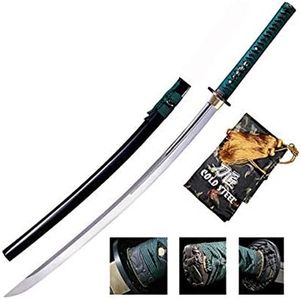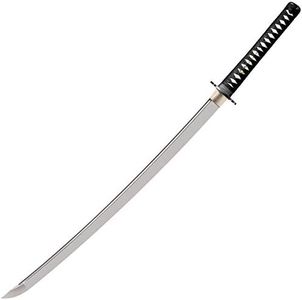Buying Guide for the Best Katanas
Choosing the right katana involves understanding the key specifications that determine its quality, functionality, and suitability for your needs. Whether you are a martial artist, a collector, or someone interested in historical weaponry, knowing what to look for in a katana will help you make an informed decision. Here are the key specifications to consider when selecting a katana and how to navigate them.Blade MaterialThe blade material is crucial as it affects the katana's durability, sharpness, and overall performance. Traditional katanas are made from high-carbon steel, which offers a good balance of hardness and flexibility. Modern katanas may also use stainless steel or other alloys. High-carbon steel is preferred for functional use due to its ability to hold a sharp edge, while stainless steel is more resistant to rust and may be better for display purposes. Choose high-carbon steel if you plan to use the katana for cutting practice or martial arts, and stainless steel if you want a low-maintenance display piece.
Blade LengthBlade length is measured from the tip of the blade to the base of the tsuba (guard). It affects the katana's balance and handling. Standard katana lengths range from 27 to 30 inches. A longer blade offers greater reach and cutting power, while a shorter blade is easier to handle and maneuver. Consider your height and arm length when choosing the blade length; taller individuals may prefer longer blades, while shorter individuals may find shorter blades more comfortable.
Blade Curvature (Sori)The curvature of the blade, known as sori, impacts the katana's cutting ability and aesthetic appeal. A deeper curve can enhance cutting efficiency and is often preferred for traditional martial arts. A straighter blade may be easier to control and is sometimes used in modern interpretations of the katana. If you are practicing traditional Japanese swordsmanship, a katana with a noticeable curve is ideal. For display or modern use, the curvature can be chosen based on personal preference.
HamonThe hamon is the visible line on the blade that indicates the differential hardening process used to create a hard edge and a softer spine. This process enhances the blade's cutting ability and flexibility. A well-defined hamon is not only a sign of quality craftsmanship but also adds to the katana's aesthetic value. If you value traditional craftsmanship and plan to use the katana for cutting, look for a clear and distinct hamon. For display purposes, the hamon can be a beautiful feature to showcase.
Tsuka (Handle)The tsuka, or handle, is where you grip the katana. It should be comfortable and provide a secure grip. Traditional tsukas are wrapped in rayskin (samegawa) and then covered with a woven silk or cotton cord. The length of the tsuka can vary, but it typically ranges from 10 to 12 inches. A longer tsuka allows for a two-handed grip, which is essential for proper technique in martial arts. Ensure the tsuka fits well in your hands and provides a firm grip to prevent slipping during use.
Tsuba (Guard)The tsuba is the guard between the blade and the handle. It protects your hands and can also be a decorative element. Tsubas come in various shapes and designs, often reflecting historical or cultural significance. A larger tsuba offers more hand protection, while a smaller tsuba may be lighter and less obtrusive. Choose a tsuba that provides adequate protection and complements the overall aesthetic of the katana.
Weight and BalanceThe weight and balance of a katana affect how it feels and performs during use. A well-balanced katana should feel comfortable and responsive in your hands. The weight can vary, but most katanas weigh between 2 to 3 pounds. Heavier katanas may offer more cutting power, while lighter katanas are easier to handle and maneuver. Consider your strength and intended use when choosing the weight and balance; a balanced katana that feels right in your hands will enhance your performance and enjoyment.

